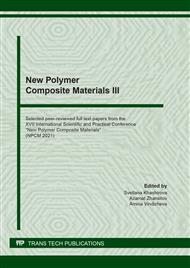[1]
Iaea. Trends in Sterilization of Health Care. October (2008).
Google Scholar
[2]
Parsons, B.J. Sterilisation of healthcare products by ionising radiation: principles and standards. Sterilisation of Biomaterials and Medical Devices (Elsevier Masson SAS., 2012).
DOI: 10.1533/9780857096265.56
Google Scholar
[3]
Jiang, J.X. at all. Effects of γ-Ray irradiation on the properties of nano-hydroxyapatite/ polyurethane composite porous scaffolds. Mater. Sci. Forum 852, 422–427 (2016).
DOI: 10.4028/www.scientific.net/msf.852.422
Google Scholar
[4]
Kang, N. H. и др. Properties of Sterilized Human Skin Allografts by Gamma-Irradiation. Key Eng. Mater. 342–343, 365–368 (2007).
Google Scholar
[5]
Puhova, I.V., Rubtsov, K.V., Kurzina, I.A., Kazakov, A.V. & Medovnik, A.V. Modification of polymer materials by electron beam treatment. Key Eng. Mater. 670, 118–125 (2015).
DOI: 10.4028/www.scientific.net/kem.670.118
Google Scholar
[6]
Kurbangaleev, Y. at all. Influence of radiation various doses on food products and feeds. Key Eng. Mater. 781 KEM, 190–194 (2018).
DOI: 10.4028/www.scientific.net/kem.781.190
Google Scholar
[7]
Abreu, M. J., Silva, M. E. C., Schacher, L. & Adolphe, D. Microscopical examination: The impact of different ionising radiation doses over protective clothing used in the operating theatre. Mater. Sci. Forum 455–456, 792–796 (2004).
DOI: 10.4028/www.scientific.net/msf.455-456.792
Google Scholar
[8]
Nanjundappa, R. & Bhat, G. S. Effect of processing conditions on the structure and properties of polypropylene spunbond fabrics. J. Appl. Polym. Sci. 98, 2355–2364 (2005).
DOI: 10.1002/app.22148
Google Scholar
[9]
Soebianto, Y. S. at all.. Degradation of polypropylene under gamma irradiation: protection effect of additives. Polym. Degrad. Stab. 50, 203–210 (1995).
DOI: 10.1016/0141-3910(95)00153-0
Google Scholar
[10]
Lisanevich, M. S. at all. Effect of processing conditions on the structure and properties of polypropylene spunbond fabrics. Key Eng. Mater. 822, 355–361 (2019).
Google Scholar
[11]
Ferreira, L. M. at all. Thermal analysis evaluation of mechanical properties changes promoted by gamma radiation on surgical polymeric textiles. Nucl. Instruments Methods Phys. Res. Sect. B Beam Interact. with Mater. Atoms 191, 675–679 (2002).
DOI: 10.1016/s0168-583x(02)00631-6
Google Scholar
[12]
Miranda, L.F., Silveira, L. H., Andrade e Silva, L. G. & Munhoz Jr., A. H. Irradiation of a Polypropilene-Glass Fiber Composite. Adv. Sci. Technol. 71, 138–144 (2010).
DOI: 10.4028/www.scientific.net/ast.71.138
Google Scholar
[13]
Shahriar Kabir, M. at all. Mechanical Properties of Gamma-Irradiated Natural Fiber Reinforced Composites. Nano Hybrids Compos. 23, 24–38 (2018).
DOI: 10.4028/www.scientific.net/nhc.23.24
Google Scholar
[14]
Chen, J. и др. Effect of γ-radiation on the property of polypropylene/nylon-6 blends. Adv. Mater. Res. 320, 69–74 (2011).
Google Scholar
[15]
Das, D. Introduction to composite nonwovens. Composite Non-Woven Materials: Structure, Properties and Applications (Woodhead Publishing Limited, 2014).
Google Scholar
[16]
Hosun, L. A review of spun bond process. J. Text. Apparel, Technol. Manag. 6, 1–13 (2010).
Google Scholar
[17]
Zhao, B. Studying on the fiber diameter of polypropylene (PP) spunbonding fabric by means of artificial neural network model and physical model. Key Eng. Mater. 426–427, 356–360 (2010).
DOI: 10.4028/www.scientific.net/kem.426-427.356
Google Scholar
[18]
Bernava, A., Reihmane, S., Bitenieks, J. & Manins, M. The nonwovens properties made from hybrid fibres. Key Eng. Mater. 721 KEM, 53–57 (2017).
DOI: 10.4028/www.scientific.net/kem.721.53
Google Scholar
[19]
Bhat, G. S., Jangala, P. K. & Spruiell, J. E. Thermal bonding of polypropylene nonwovens: Effect of bonding variables on the structure and properties of the fabrics. J. Appl. Polym. Sci. 92, 3593–3600 (2004).
DOI: 10.1002/app.20411
Google Scholar
[20]
Ajmeri, J. R. & Ajmeri, C. J. Developments in nonwoven materials for medical applications. Advances in Technical Nonwovens (Elsevier Ltd, 2016).
DOI: 10.1016/b978-0-08-100575-0.00008-5
Google Scholar
[21]
Ajmeri, J. R. & Ajmeri, C. J. Nonwoven materials and technologies for medical applications. Handbook of Medical Textiles (Woodhead Publishing Limited, 2011).
DOI: 10.1533/9780857093691.1.106
Google Scholar
[22]
Ajmeri, J. R. & Ajmeri, C. J. Nonwoven personal hygiene materials and products. Appl. Nonwovens Tech. Text. 85–102 (2010).
DOI: 10.1533/9781845699741.2.85
Google Scholar
[23]
Philippe, F., Abreu, M. J., Schacher, L., Adolphe, D. C. & S.M.E., C. Influence of the sterilisation process on the tactile feeling of surgical gowns. Int. J. Cloth. Sci. Technol. 15, 268–275 (2003).
DOI: 10.1108/09556220310478378
Google Scholar
[24]
Abreu, M. J., Silva, M. E., Schacher, L. & Adolphe, D. Designing surgical clothing and drapes according to the new technical standards. Int. J. Cloth. Sci. Technol. 15, 69–74 (2003).
DOI: 10.1108/09556220310461178
Google Scholar
[25]
Pamuk, O., Abreu, M. J. & Öndogan, Z. An investigation on the comfort properties for different disposable surgical gowns by using thermal manikin. Tekst. ve Konfeksiyon 18, 236–239 (2008).
Google Scholar
[26]
Pamuk, O., Ondočjan, Z. & Abreu, M. J. The thermal comfort properties of reusable and disposable surgical gown fabrics. Tekstilec 52, 24–30 (2009).
Google Scholar
[27]
Andreassen, E., Myhre, O. J., Hinrichsen, E.L., Braathen, M.D. & Grøstad, K. Relationships between the properties of fibers and thermally bonded nonwoven fabrics made of polypropylene. J. Appl. Polym. Sci. 58, 1633–1645 (1995).
DOI: 10.1002/app.1995.070580926
Google Scholar
[28]
Rakhmatullina, E. R., Lisanevich, M. S., Galimzyanova, R. Y. & Khakimullin, Y. N. The effect of radiation sterilization on the stress-strain properties of non-woven materials-based on polypropylene. Mater. Sci. Forum 992 MSF, 403–408 (2020).
DOI: 10.4028/www.scientific.net/msf.992.403
Google Scholar
[29]
Lisanevich, M.S., Rakhmatullina, E.R. & Khakimullin, Y.N. Galimzyanova R.Yu. The Effect of Polyquinone and Phenol-Phosphite Stabilizer on the Resistance of Polypropylene to Ionizing Radiation. 816, 328–332 (2019).
DOI: 10.4028/www.scientific.net/kem.816.328
Google Scholar
[30]
Li, M., Xiao, L.G. & Zhao, H.K. Characterization of gamma irradiated isotactic polypropylene by mixtures of hindered amine/organo-phosphite stabilizers. Appl. Mech. Mater. 457–458, 297–300 (2014).
DOI: 10.4028/www.scientific.net/amm.457-458.297
Google Scholar
[31]
Il'icheva, E. S., Khusainov, A. D., E.N., C. & E.M., G. High-molecular-weight modifiers with graft anhydride and imide groups: effect on the adhesion, rheological, and physicomechanical properties of rubber compounds. Int. Polym. Sci. Technol. 42, 117–120 (2015).
DOI: 10.1177/0307174x1504200604
Google Scholar
[32]
Volfson, S.I., Zakirova, L.Y., Karaseva, Y.S. & Nigmatullin, A.I. Effect of the technological additives on the properties of recycled polyolefins. Key Eng. Mater. 816 KEM, 90–95 (2019).
DOI: 10.4028/www.scientific.net/kem.816.90
Google Scholar


